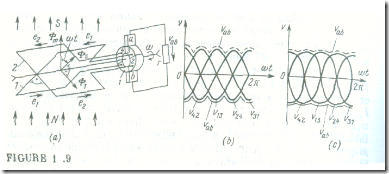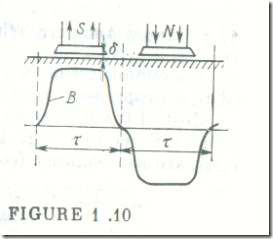Operation of Brushgear and the Commutator
An alternating emf is induced in the rotating armature winding of a d.c. machine, and it needs rectification, which is done by the commutator.
The rectification of the emf induced in a d.c. machine can conveniently be traced using as an example a d.c. generator (Fig. 1.9 a) in which the armature core is absent , the magnetic field set up by the main poles is uniform, and the armature winding is made up of two separate turns, 1 and 2, arranged to be at right angles to each other and connected to the commutator .
When the turns 1 and 2 rotate clockwise at an angular velocity ω
, an emf is induced in them, its positive direction being given by the corkscrew rule (see Fig. 2.5 b), and its magnitude being given
by Eq. (2.15)
e1 = — dΦ1/dt = Em cos ωt
e2 = — dΦ2/dt = Em sin ωt
where Φ1 = — Φm sin ωt and Φ 2 = Φm cos ωt are the components of the main flux Φm, normal to the planes of the turns 1 and 2.
Since the turn 1 is connected to commutator bars 1 and 3, and the turn 2 to commutator bars 2 and 4, the voltages existing between the respective pairs of bars will be
v13 = e1 = Em cos ωt
v24 = e1 = Em sin ωt
When the armature is rotating clockwise, the external circuit is connected to the turns 1 and 2 via the stationary brushes located in a vertical plane and the commutator in such a way that during one complete revolution of the commutator its bars will come in contact with brush a in the sequence 3, 4, 1, 2, 3 and with brush b in the sequence 1, 2, 3, 4, 1. As a result the voltage between brushes a and b, which is the terminal voltage of the generator, will vary in the same sequence as the brushes come in contact with the commutator bars: vab = v31 , vab = v42 , vab = vl3 , vab = v24 , and vab = v31 (represented by the full line in Fig. 1.9 b), were
v31 = vl3 = — Em cos ωt
v42 = v24 = — Em sin ωt
If we reverse the direction of rotation of the turns and the commutator, two things will happen. Firstly, the component of the main flux normal to the plane of turn 1 will change sign so that Φ1 = Φ m sin ωt , and so will the emf induced in that turn, e1 = — dΦ1/dt = —Em cos ωt Secondly, the commutator bars now come in contact with brush a in the sequence 3, 2, 1, 4, 3, and with brush b in the sequence 1, 4, 3, 2, 1. Accordingly, the terminal voltage of the generator will change in the same sequence: vab = v31 , vab = v24 , vab = vl3 , vab = v42 , and vab = v31 (represented by the dashed line in fig. 1.9 b) , where
v13 = el = — Em cos ωt
v31 = — v13 = — Em cos ωt
v24 = e2 = Em cos ωt
v42 = —v24 = — Em sin ωt
Owing to the use of a ferromagnetic armature core and pole faces the magnetic induction B is uniformly distributed in the air gap of δ the machine (Fig. 1.10), thereby minimizing pulsations (or ripple) in the generator voltage. If in the d.c. generator of Fig. 1.9 a we place the turns 1 and 2 in the slots of an armature rotating in the magnetic field set up by a pair of main poles (p = 1) fitted with pole faces, the terminal voltage of the generator (Fig. 1.9 c) will show a reduced ripple as compared with the rotation of the turns in a uniform magnetic field (see Fig. 1.9 b).
If a machine has more than one pair of poles, it has to have a greater number of brushes in order to interconnect the parallel circuits in the armature winding. Figure 1.11 a show the connection
for a four-pole d.c. generator (p = 2) in which two single-turn windings 1 and 2 are connected in parallel. The identical alternating emfs (e1 = e2) induced in the turns 1 and 2 vary at an angular frequency 2ω and are rectified by the commutator (see Fig. 1.11 b) .
in a generator, brushes and a commutator are required in order to rectify the alternating emf induced in the armature winding. In a motor, brushes and a commutator are needed in order to keep the armature rotating in one and the same direction. In all conductors of the parallel paths in the armature winding the current is the same and equal to I = 7arra/2a, where a is the number of pairs of parallel paths. When all of these conductors are acted upon by an electromagnetic force in the same direction, the motor develops a maximum torque. Just as a conductor passes from one pole to another the brushes and the commutator reverse the current in that conductor. As a result, the torque always acts in one and the same direction.



